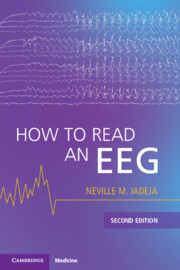Book contents
- How to Read an EEG
- Reviews
- How to Read an EEG
- Copyright page
- Dedication
- Contents
- Figure Contributions
- Foreword to the First Edition
- Preface
- How to Read This Book
- Part I Basics
- Part II Interpretation
- Part III Specific Conditions
- Chapter 15 Seizure Mimics
- Chapter 16 Types of Seizures
- Chapter 17 Epilepsy
- Chapter 18 Epilepsy Syndromes
- Chapter 19 Lesions and Encephalopathy
- Chapter 20 Status Epilepticus
- Chapter 21 Postcardiac Arrest
- Appendix: How to Write a Report
- Index
- References
Chapter 18 - Epilepsy Syndromes
from Part III - Specific Conditions
Published online by Cambridge University Press: 27 September 2025
- How to Read an EEG
- Reviews
- How to Read an EEG
- Copyright page
- Dedication
- Contents
- Figure Contributions
- Foreword to the First Edition
- Preface
- How to Read This Book
- Part I Basics
- Part II Interpretation
- Part III Specific Conditions
- Chapter 15 Seizure Mimics
- Chapter 16 Types of Seizures
- Chapter 17 Epilepsy
- Chapter 18 Epilepsy Syndromes
- Chapter 19 Lesions and Encephalopathy
- Chapter 20 Status Epilepticus
- Chapter 21 Postcardiac Arrest
- Appendix: How to Write a Report
- Index
- References
Summary
Epilepsy syndromes (electroclinical syndromes) are well-recognized groupings of clinical (seizure types) and EEG features that occur together. Each syndrome typically shares a common age of onset, deficits (intellectual dysfunction), treatment and prognosis. Syndromes are classified based on their onset, epilepsy type (focal, generalized, or mixed) and development of epileptic encephalopathy (disorder in which epileptic activity contributes to severe impairments in cognition and behavior). Relatively benign syndromes are typically associated with focal, generalized tonic-clonic (GTC), typical absences and myoclonic seizures. Epileptic encephalopathies are typically associated with atonic, tonic, atypical absences, and epileptic spasms in addition to the other seizure types. [106 words/729 characters]
Information
- Type
- Chapter
- Information
- How to Read an EEG , pp. 259 - 283Publisher: Cambridge University PressPrint publication year: 2025
References
Accessibility standard: WCAG 2.2 AAA
Why this information is here
This section outlines the accessibility features of this content - including support for screen readers, full keyboard navigation and high-contrast display options. This may not be relevant for you.Accessibility Information
Content Navigation
Allows you to navigate directly to chapters, sections, or non‐text items through a linked table of contents, reducing the need for extensive scrolling.
Provides an interactive index, letting you go straight to where a term or subject appears in the text without manual searching.
Reading Order & Textual Equivalents
You will encounter all content (including footnotes, captions, etc.) in a clear, sequential flow, making it easier to follow with assistive tools like screen readers.
You get concise descriptions (for images, charts, or media clips), ensuring you do not miss crucial information when visual or audio elements are not accessible.
You get more than just short alt text: you have comprehensive text equivalents, transcripts, captions, or audio descriptions for substantial non‐text content, which is especially helpful for complex visuals or multimedia.
Visual Accessibility
You will still understand key ideas or prompts without relying solely on colour, which is especially helpful if you have colour vision deficiencies.
You benefit from high‐contrast text, which improves legibility if you have low vision or if you are reading in less‐than‐ideal lighting conditions.
